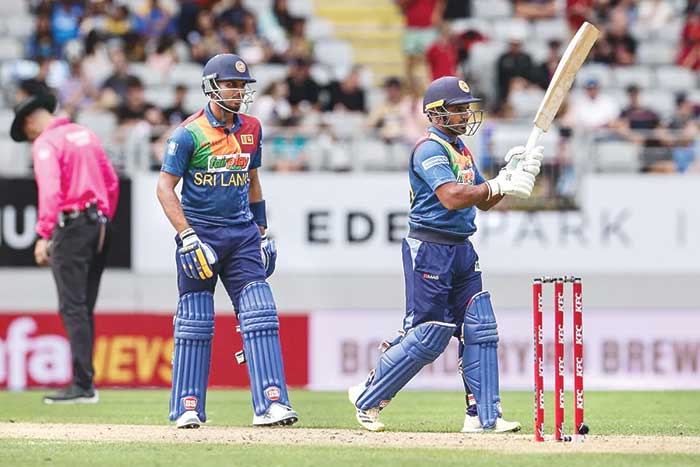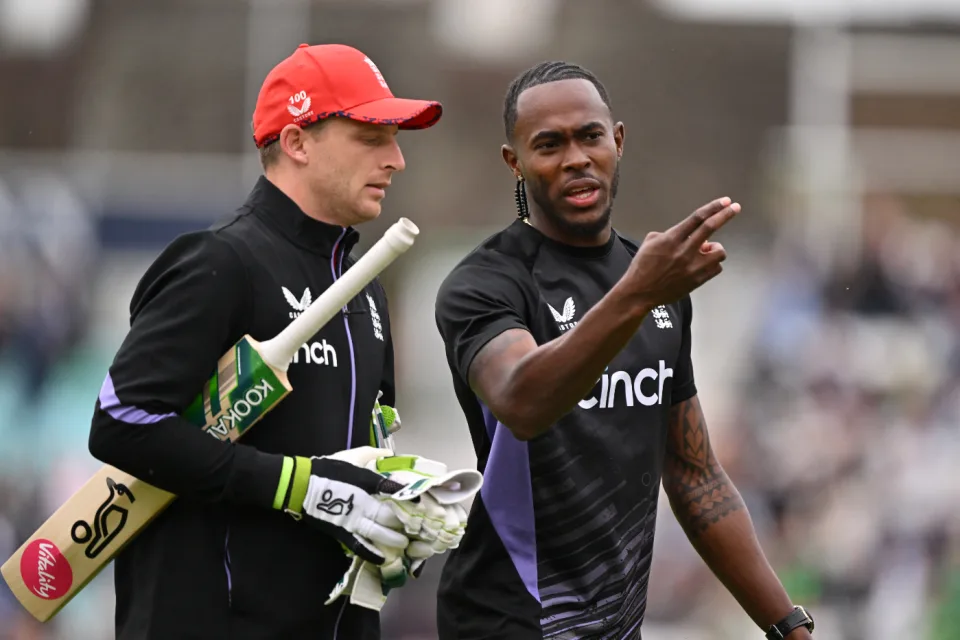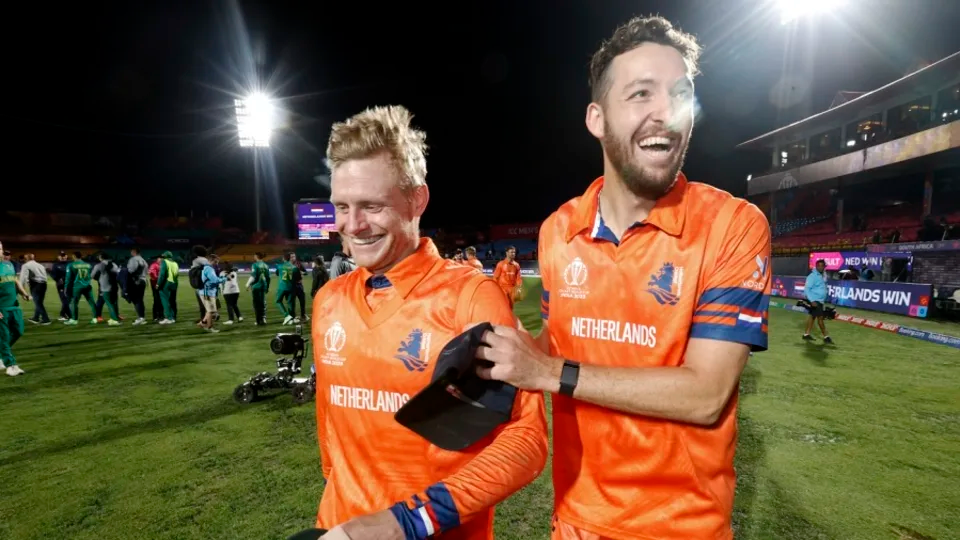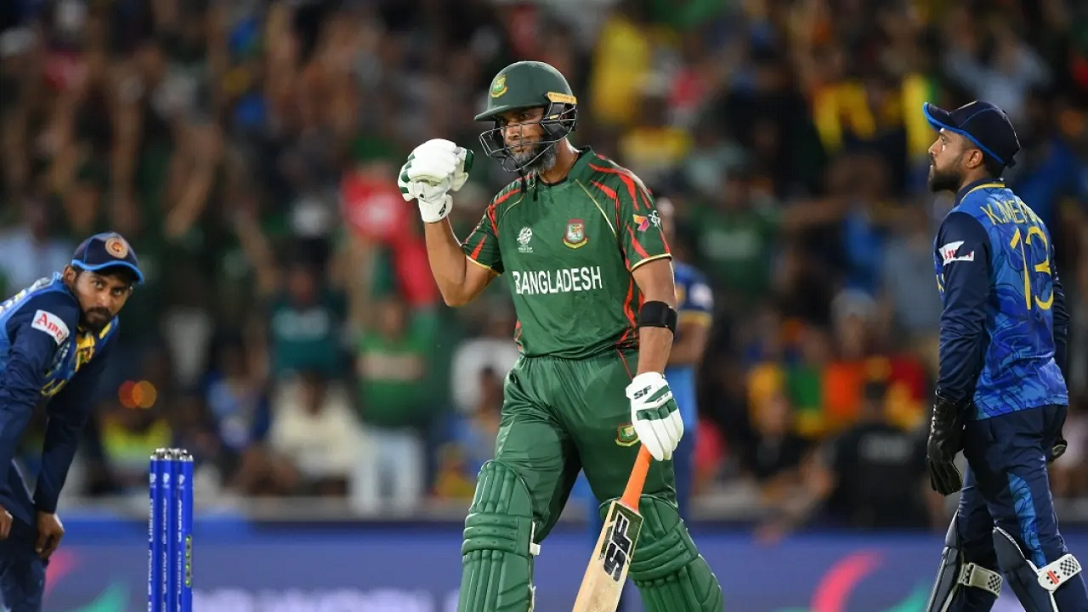Sports
Asalanka, Theekshana star in Sri Lanka’s Super Over win against New Zealand

Ish Sodhi’s last-ball six tied the game after Dasun Shanaka looked to have almost won it for the visitors defending 12 off the final over, but Maheesh Theekshana held his nerve in the Super Over before Charith Asalanka chased down the nine-run target, to give Sri Lanka their first win of the tour.
It was fitting that Asalanka was the man left at the end after his 41-ball 67 had helped propel Sri Lanka to a challenging 196 for 5 at Eden Park. Kusal Perera, back in the limited-overs side for the first time in over a year, also made a triumphant return batting through the innings for a 45-ball 53. With his thirteenth half-century in T20Is, he equalled Tillakaratne Dilshan’s record for the most fifties in the format for Sri Lanka.
While that would normally be an imposing total, Eden Park with its odd dimensions and especially short boundaries straight down the ground, meant Sri Lanka could never relax in their defence of it. And so it proved.
Despite some early wickets in their chase, New Zealand’s batters – particularly Daryl Mitchell, who struck five fours and three sixes in his 44-ball 66 – found boundaries with regularity to keep up with the near 10-an-over required rate.
But even if keeping the scoring down was proving difficult, especially later on with a bit of drizzle wetting the ball, Sri Lanka did well to keep picking up wickets at crucial junctures, and in the end did better in the key moments to secure a much-needed win.
Mendis lays the platform
When Pathum Nissanka nicked one through first ball, the hosts might have had allusions towards repeating the collapse from the first ODI, but Kusal Mendis quickly put paid to any such notions. In a nine-ball cameo the diminutive right-hand batter plundered 25 runs, 24 of which came in boundaries. Adam Milne took the brunt of Mendis’ wrath in a 22-run third over, inclusive of two sixes, one an impetuous flick over the shoulder. By the time Mendis departed, holing out at short fine leg after attempting another cheeky ramp, Sri Lanka had raced to 47 off just 3.2 overs.
Perera and Asalanka keep up
the momentum
Sri Lanka lost three wickets inside the powerplay, but their scoring rate never dipped. Following Mendis’ early onslaught, Dhananjaya de Silva stepped in for a 10-ball 15, before Asalanka and Perera took hold of proceedings. Perera had earlier smoked three consecutive boundaries through the off side, ranging from the arc behind point to straight of mid-off, but once Asalanka joined in, he took a back seat. Unsurprisingly, Asalanka favoured the short straight boundaries, walloping five of his six sixes in the arc in front of the pitch. New Zealand would pull things back after Asalanka’s departure, allowing just 11 runs from overs 17 to 19, but such was the platform set by the two half-centurions, an 18-run last over, courtesy Wanindu Hasaranga, was enough to put some gloss on the innings at the death.
Mitchell shows his might
Sri Lanka looked to have orchestrated a dream start to the defence of their total, getting rid of Tim Seifert and Chad Bowes inside the first two overs, but then entered Mitchell. Off just the third delivery he faced, Mitchell showed his intent, sending a high-elbow lofted drive sailing over the short straight boundary, before repeating the trick in Dilshan Madushanka’s next over as well. At the other end, Tom Latham kept the required rate in control, ensuring at least a boundary each over. Together the pair added 63 off 39 deliveries. After Latham fell, Mitchell carried on, putting on a 40-ball 66-run stand with Mark Chapman. The two also memorably combined for an almost game-changing 24-run 12th over off Madushanka.
Sri Lanka hold their nerve
In a game where runs came easy, it was always going to be small periods that shifted momentum either way, and it was in these periods that Sri Lanka won the game. First there was the counterattack following Nissanka’s early dismissal, and then Wanindu’s last over flourish. Then with the ball after Mitchell had struck with a counter of his own, captain Shanaka brought himself on to dismiss the danger man. In the final over too, Shanaka took out the equally dangerous Rachin Ravindra, whose 13-ball 26 had brought the hosts within a whisker. And then finally, the excellent Theekshana bowled a Super Over of immense quality to ensure his batters had only a minimal chase on their hands. (cricinfo)

Sports
England face Australia in the battle of champions

The first truly heavyweight clash of this expanded T20 World Cup format comes freighted with both history and subplots. A rematch of the 2010 World T20 final at Kensington Oval, the match pits Jos Buttler’s defending champions – who are aiming to become the first team to retain the trophy – against the Australian winning machine, victors at the 2021 edition and current world title-holders in Test and ODI cricket. And that’s before you throw in the Ashes for afters.
Already there is added pressure on England, after the rain in Bridgetown led to a share of the points in their opener against Scotland (and that having conceded 90 runs from 10 overs without taking a wicket in a tepid bowling display). Lose to their oldest rivals and it will leave their Super 8 prospects open to being waylaid by the perils of net run-rate calculations, or worse.
The Scotland match was the third abandonment in five suffered by England, after a rain-affected home series against Pakistan, which has clearly hampered their readiness for this campaign after almost six months without playing T20 together. It does not take much for a side to click in this format – and England looked in decent shape when they did get on the field against Pakistan – but Buttler will be anxious for things to go their way on Saturday, if only to avoid further questions referencing the team’s disastrous ODI World Cup defence last year.
Australia, under the laidback leadership of Mitchell Marsh would love nothing more than to add to the English sense of jeopardy – having helped bundle them out of the tournament in India on the way to taking the crown. Their head to head record is less impressive in T20 however, with England having won six of the last seven completed encounters, as well as that 2010 final.
Despite a wobble with the bat, Australia avoided mishap against Oman earlier in the week, the experience of David Warner and Marcus Stoinis shining through in difficult batting conditions. Surfaces in the Caribbean – not to mention those games staged in the USA – have already had teams scratching their heads; rather than the “slug-fest” England had prepared for, following a high-scoring tour of the Caribbean in December, it looks as if boxing smart may be the way to go.
Speaking of Warner, this could be the last time he faces up against England in national colours – and another match-winning contribution would likely reduce the chances of them meeting again in the knockouts. On the other side of the card is Jofra Archer, fresh from an emotional maiden outing at Kensington Oval and ready to take on Australia for the first time in any format since 2020. Can Mark Wood fire up England’s campaign, as he did during last summer’s Ashes? Will Pat Cummins be back to harass the old enemy once again? Seconds out, it’s almost time to rumble.
Cummins is set to return after being rested for the Oman game, which saw Mitchell Starc leave the field with cramp. Starc is understood to be fine and could keep his place – which would likely see Nathan Ellis miss out. Marsh is still not fit to bowl, with Australia likely to continue with the allrounder combination of Stoinis and Maxwell to give them cover.
Australia (probable XI): David Warner, Travis Head, Mitchell Marsh (capt), Glenn Maxwell, Marcus Stoinis, Josh Inglis (wk), Tim David, Pat Cummins, Nathan Ellis/Mitchell Starc, Adam Zampa, Josh Hazlewood
The one change England may consider is Reece Topley coming in for Wood, with the expectation that there will be some rotation among the seamers through the course of the tournament.
England (probable XI): Phil Salt, Jos Buttler (capt & wk), Will Jacks, Jonny Bairstow, Harry Brook, Liam Livingstone, Moeen Ali, Chris Jordan, Jofra Archer, Adil Rashid, Reece Topley/Mark Wood
[Cricinfo]
Sports
South Africa up against their bogey team in batter-unfriendly New York

Once is coincidence, twice is a clue, and three times is proof.
To paraphrase Agatha Christie, that is the narrative around South Africa’s meeting with Netherlands at this T20 World Cup.
The Dutch beat South Africa at the 2022 tournament and ended their semi-final hopes in a match where South Africa appeared to be sleep walking, and then beat them again at the 2023 ODI World Cup, where they exposed South Africa’s vulnerability in the chase. If they to do the treble, not only will Netherlands take the lead in Group D, but they will offer conclusive evidence of the threat they pose to Full Members, especially South Africa.
Of course, it will take some doing after South Africa’s opening performance against Sri Lanka, where they reduced their opposition to their lowest T20I total and chased it down in fairly straightforward fashion thanks to the most stable middle-order of their white-ball era. In Aiden Markram, Tristan Stubbs, Heinrich Klaasen and David Miller, South Africa have bankers and big-hitters and, for this match, they also have the advantage of experience. They’ve already played at Eisenhower Park, and have first-hand knowledge that run-scoring doesn’t come easily;Klassen said they are prepared to use their “cricket brains” and play “smarter cricket”.
But the conditions could be good news for Netherlands, who are not naturally a line-up of big hitters and build their innings on a foundation of turning ones into twos. In other words, they tend to take a slightly more conservative approach to batting, which may work well here, but they’ll be wary of the uneven bounce of the surface and will have to come up with plans to counterattack especially against South Africa’s seamers. Their own bowlers were exemplary in Dallas and will look to build on that performance against a line-up that will likely be more proactive than Nepal’s, but who they have managed to keep quiet not once, but twice in the past. Third time’s the charm, they say.
Anrich Nortje’s stunning return to form against Sri Lanka means South Africa may not have to tinker with the bowling combination, and Gerald Coetzee and Tabraiz Shamsi may have to wait their turns to get a game. The batting line-up should be unchanged, with no space for Ryan Rickelton yet.
South Africa: Quinton de Kock (wk), Reeza Hendricks, Aiden Markam, Tristan Stubbs, Heinrich Klaasen (wk), David Miller, Marco Jansen, Keshav Maharaj, Kagiso Rabada, Ottneil Baartman, Anrich Nortje
Conditions in New York may tempt Netherlands to include an extra seamer and they have Kyle Klein in their squad. But it could come at the expense of a shortened batting line-up and they may not want to risk that.
Netherlands: Michael Levitt, Max O’Dowd, Vikramjit Singh, Sybrand Engelbrecht, Scott Edwards (capt, wk), Bas de Leede, Teja Nidamanuru, Logan van Beek, Tim Pringle, Paul van Meekeren, Vivian Kingma
[Cricinfo]
Latest News
Mustafizur, Rishad, Hridoy dazzle in Bangladesh’s tight two-wicket win over Sri Lanka

Nuwan Thushara’s last over brought Sri Lanka screaming back into the match,as he first bowled Rishad Hossain, and then nailed Taskin Ahmed in front of the stumps with a pinpoint swinging yorker. This left Bangladesh eight wickets down, with 12 runs still to get.
However, the experienced Mahmudullah was at the crease for Bangladesh, and despite some further nervy moments, pushed Bangladesh across the line off the last ball of the 19th over.
But this was a match chiefly decided by Bangladesh’s own outstanding bowling. Mustafizur Rahman was the best among them, using shorter lengths and his cutters efficiently, to claim figures of 3 for 17. Rishad Hossain’s three-for through the middle overs also kept Sri Lanka quiet.
Mustafizur was instrumental in Sri Lanka’s downward spiral through the middle overs, which culminated in a crash-and-burn end. Ultimately, their inability to find boundaries, or even rotate strike against good Bangladesh bowling resulted in their downfall. A score of 125 for 9 always seemed poor on a decent pitch, even if their bowlers made a match of it in the end.
Brief scores:
Bangladesh 125 for 8 in 19 overs (Towhid Hridoy 40, Litton Das 36; Dhanajaya de Silva 1-11, Nuwan Thushara 4-18, Wanidu Hasaranga 2-32, Matheesha Pathirana 1-27) beat Sri Lanka124 for 9 in 20 overs (Pathum Nissanka 47, Dhananjaya de Silva 21; Tanzim Hasan Sakib 1-24, Taskin Ahmed 2-25, Mustafizur Rahman 3-17, Rishad Hossain 3-22) by two wickets
[Cricinfo]





















